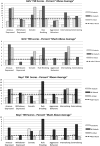Are affluent youth truly "at risk"? Vulnerability and resilience across three diverse samples
- PMID: 22559123
- PMCID: PMC4385271
- DOI: 10.1017/S0954579412000089
Are affluent youth truly "at risk"? Vulnerability and resilience across three diverse samples
Abstract
Building upon prior findings of elevated problems among East Coast suburban youth through the 11th grade, this study establishes disproportionately high incidence of maladjustment across three disparate samples: East Coast Suburban youth at the end of their senior year in high school, and 11th and 12th graders in (a) a Northwest suburb and (b) an East Coast city. Both East Coast samples showed pronounced elevations in substance use, whereas the Northwest suburban sample showed marked vulnerability in serious internalizing and externalizing symptoms. Across all samples, parents' low perceived containment for substance use (lax repercussions on discovering use) was a major vulnerability factor, followed by parents' knowledge of their teens' activities. Overall, adolescents' symptom levels were more strongly related to their relationships with mothers than with fathers. An exception was boys' apparent vulnerability to fathers', but not mothers', perceived depressive symptoms. As with affluent eighth graders, we found that "overscheduling" in extracurriculars is not a critical vulnerability factor among these high school students. Finally, youth reports suggested that most affluent parents do not indiscriminately bail their children out of all problem situations (although a small subset, apparently, do). Results are discussed along with the implications for practice and for future research.
Figures





References
-
- Achenbach TM, Rescorla LA. Manual for the ASEBA school-age forms & profiles. Burlington, VT: University of Vermont, Research Center for Children, Youth, & Families; 2001.
-
- Anderson J. At Dalton, a student survey reveals dual identities. New York Times. 2011 Nov 22; Retrieved from http://www.nytimes.com/2011/11/23/education/at-dalton-a-student-survey-r....
-
- Anderson J, Applebome P. Exam cheating on Long Island hardly a secret. New York Times. 2011 Dec 2; Retrieved from http://www.nytimes.com/2011/12/02/education/on-long-island-sat-cheating-....
-
- Armsden GC, Greenberg MT. The Inventory of Parent and Peer Attachment: Individual differences and their relationship to psychological well-being in adolescence. Journal of Youth & Adolescence. 1987;16:427–454. - PubMed
Publication types
MeSH terms
Grants and funding
LinkOut - more resources
Full Text Sources
Research Materials
Miscellaneous

